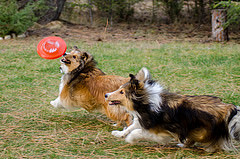Some dogs seems to live to chase. Whether they are a terrier seeing a bunny as their next meal or a herding dog who believes the kids need to be rounded up at all times—if something is moving, it needs to be chased.
But chasing is dangerous. Your dog can get lost, hit by a car, or injure whatever he is chasing. If he is on leash, he can injure you while trying to pull you toward his fixation.
Why Dog’s Chase
There are lots of reasons a dog could be chasing something: guarding their territory, wants to play, instinctual prey or herding drive, are just some of the reasons. Not to mention it is fun! They feel a rush when they are chasing after that elusive cat, dog, bird, bunny, kid. Or, conversely, some dogs do it out of fear. If they act tough – bark and chase – the thing that is scaring them will go away.
You may never fully know why your dog is barking and chasing at every little thing. However, noticing your dog’s body language may help you decipher what’s behind his chasing habits.
- Does he show signs of stress and fear, even though he looks ferocious?
- Is he a herding breed or mix displaying herding behaviors (nipping at heels, circling, barking and running when someone leaves the room)?
- Is he a terrier breed or mix that displays predatory behaviors such as staring, stalking, and silent chase?
- Does he display play behaviors such as play bows, pawing, and high-pitched barks when he reaches the object (regardless of species)?
None of these questions will completely answer why your dog chases. And many dogs chase for more than reason. He may chase a bunny like prey but a dog because he wants to play and a human because he is afraid and wants them to leave. They are just prompts to get you thinking about why your dog is doing something.
The main thing to realize is that regardless the reason, it’s self-reinforcing. For example, the dog that is scared and wants whatever he is chasing to leave, 99.99% of the time it works, so they are reinforced for doing it. The dog that’s loves the chase is getting exactly what he wants and, for the herding dog, well he is doing his job which makes him happy.
Tips to Stop Them
Even though you can’t ever know for sure what your dog is thinking or why he is doing something, having some idea can help you decide which training methods will work in getting him to stop chasing.
Premack Principle

If your dog is chasing because he wants that bunny than you can use the Premack Principle to curb the behavior. All this means is, you do what I want to get to do what you want (eat your veggies before dessert). So, if your dog comes to you and doesn’t chase the bunny, he gets to chase it. It’s a way to teach your dog to “ask for permission.” You can put “chase” on a cue, and then never use it (unless you want to as a reward).
Look at That
If your dog is afraid of things and that is why he is chasing, to get them to go away, then you need to do counter conditioning. This way, you can teach your dog that the scary thing means cookies and you can give him something else to do (look at you) instead of chasing.
Start far away from the object and click/treat him for looking at whatever it is that he normally chases, without reacting. You will have to play with the distance until you learn how far away is far enough that he is comfortable. Then, have the object leave while he is calm. Treats also stop. Bring the object back out, treats come back out.
Make sure you are using HIGH VALUE treats – chicken, steak, cheese, etc. Remember, your reinforcement has to be better than the reinforcement of chasing it away. In the beginning, anyway.
Chasing Kids
For those that are chasing kids, usually herding breeds, you can work on teaching your kids to stop moving as soon as the dog chases. When he stops and calms down, the kids can run again. This teaches the puppy that if he wants the game to continue he can’t chase and nip. It worked really well for my Shetland sheepdog pup, he stopped biting after a week doing this (and he also herds, so they definitely can learn the difference between livestock and your kids).
The bottom line
You need to either remove the reinforcement in chasing or create a reinforcement that is greater than the one your dog gets when she chases. Otherwise, you will never be able to stop the chase.
About the Author
Based in Wilsonville, Ore., animal lover Kristina N. Lotz is a Certified Professional Dog Trainer – Knowledge Assessed (CPDT-KA) and works as a full time trainer. She is the founder of A Fairytail House, a unique all-positive all-sport dog training facility that helps rescue dogs in her area and provides free seminars and training classes for the community. In her spare time, she trains and competes in herding, agility, obedience, rally, and conformation with her Shetland Sheepdogs. She smartly married a Veterinary Technician, who helps keep the fur kids happy and healthy, and provides a quick resource for articles.
